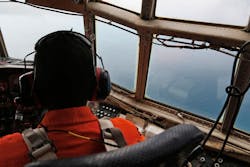Why We Still Can't Track An Airplane
The disappearance of a Malaysia Airlines jumbo jet last March shocked many people unaware that such a thing could happen. That event, combined with Sunday's loss of a second commercial aircraft over the Java Sea (debris from the plane is now being recovered), is spurring calls for more precise, “persistent” tracking of commercial airline flights. For airlines, the real question is how to balance the costs of a locator system that's almost never needed against the hard fact that Airbus A320s and Boeing 777s cannot be allowed to vanish without a trace.
The overarching problem with tracking planes is the vast expanse of earth devoid of radar coverage: Most of the oceans, polar regions, and areas of Africa, Asia, and South Africa—as much as 80 percent of the world—are “a blind spot to surveillance,” the director of Nav Canada, the company that runs the country's air traffic control system, told the National Post last week. That means ubiquitous flight tracking via satellite is likely inevitable across the industry, and not just among major airlines with flights across the world.
More details here.
